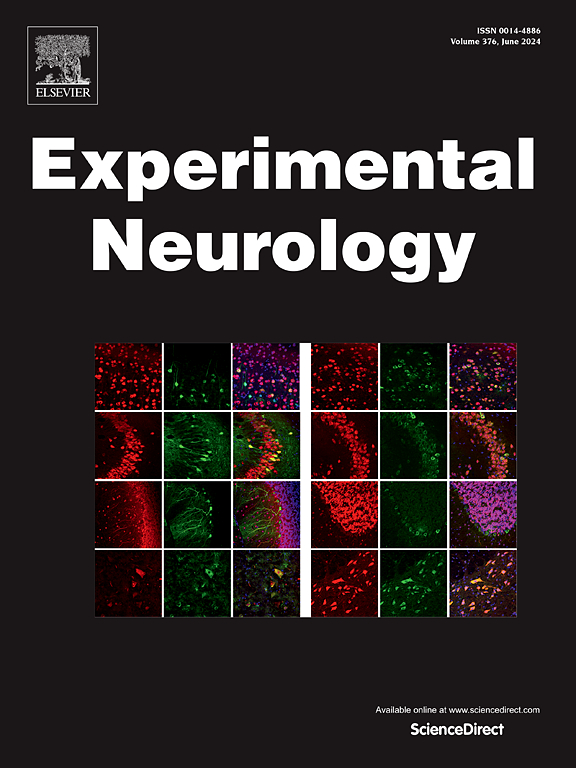缺氧-葡萄糖剥夺的外周血单核细胞对缺血-再灌注损伤后缺氧损伤的作用。
IF 4.6
2区 医学
Q1 NEUROSCIENCES
引用次数: 0
摘要
背景:尽管在再灌注治疗方面取得了进展,但缺血性脑卒中仍然是大血管再灌注后残留的缺氧损伤导致长期残疾的主要原因。这些由微血管功能障碍引起的残留缺氧损伤是一个重要的治疗靶点。我们之前证明了缺氧葡萄糖的外周血单个核细胞(OGD-PBMCs)迁移到缺血性脑区域并促进脑卒中后的功能恢复。这种恢复通过缺氧诱导因子-1α、外泌体miR-155-5p和血管内皮生长因子(VEGF)的机制发生。然而,ogd - pbmc是否靶向缺氧区域仍不清楚。方法:我们使用激光散斑血流成像系统评估脑血流。接下来,我们利用吡莫硝唑对大鼠缝合闭塞模型缺血再灌注损伤后的缺氧病变进行免疫组织化学分析。我们还通过流式细胞术分析比较了常氧和OGD条件下人类pbmc细胞表面受体的水平。结果:我们在再灌注后10天和28天发现持续的吡硝唑阳性缺氧病变,尽管脑灌注恢复。与对照组相比,使用C-X-C基序趋化因子受体4 (CXCR4)抑制剂AMD3100治疗ogd - pbmc前后减少了脑实质中ogd - pbmc的数量(P = 0.018)。通过基质细胞衍生因子-1/CXCR4趋化轴将ogd - pbmc定位于这些缺氧区域。与磷酸盐缓冲盐水组相比,OGD-PBMC增强了VEGF表达,特别是在缺氧病灶内(P )结论:针对这些残余缺氧区域可能强调了OGD-PBMC治疗的治疗效果,并代表了一种有希望的策略,可以改善卒中再通成功后的恢复。本文章由计算机程序翻译,如有差异,请以英文原文为准。
Oxygen–glucose-deprived peripheral blood mononuclear cells act on hypoxic lesions after ischemia-reperfusion injury
Background
Despite advances in reperfusion therapies, ischemic stroke remains a major cause of long-term disability due to residual hypoxic lesions persisting after macrovascular reperfusion. These residual hypoxic lesions, caused by microvascular dysfunction, represent an important therapeutic target. We previously demonstrated that oxygen–glucose-deprived peripheral blood mononuclear cells (OGD-PBMCs) migrate to ischemic brain regions and promote functional recovery after stroke. This recovery occurs through mechanisms involving hypoxia-inducible factor-1α, exosomal miR-155-5p, and vascular endothelial growth factor (VEGF). However, it remains unclear whether OGD-PBMCs target hypoxic regions.
Methods
We evaluated cerebral blood flow using a laser speckle flow imaging system. Next, we utilized pimonidazole to investigate the presence of hypoxic lesions after ischemia–reperfusion injury in a rat suture occlusion model in immunohistochemical analyses. We also compared levels of a cell surface receptor in human PBMCs by flow cytometric analysis under normoxic and OGD conditions.
Results
We found persistent pimonidazole-positive hypoxic lesions at 10- and 28-days post-reperfusion despite restored gross cerebral perfusion. Treatment with the C-X-C motif chemokine receptor 4 (CXCR4) inhibitor AMD3100 before and after OGD-PBMCs administration reduced the number of OGD-PBMCs in the brain parenchyma compared to the control group (P = 0.018). Administered OGD-PBMCs localized within these hypoxic regions via the stromal cell-derived factor-1/CXCR4 chemotactic axis. OGD-PBMCs enhanced VEGF expression, specifically within hypoxic lesions, compared to the phosphate-buffered saline group (P < 0.01). Furthermore, OGD-PBMCs reduced the number of pimonidazole-positive hypoxic cells in the ischemic core on 28 days. These findings demonstrate that OGD-PBMCs selectively migrate to and modulate the microenvironment of hypoxic lesions following cerebral ischemia-reperfusion injury.
Conclusion
Targeting these residual hypoxic regions may underline the therapeutic effects of OGD-PBMC treatment and represent a promising strategy for improving stroke recovery despite successful recanalization.
求助全文
通过发布文献求助,成功后即可免费获取论文全文。
去求助
来源期刊

Experimental Neurology
医学-神经科学
CiteScore
10.10
自引率
3.80%
发文量
258
审稿时长
42 days
期刊介绍:
Experimental Neurology, a Journal of Neuroscience Research, publishes original research in neuroscience with a particular emphasis on novel findings in neural development, regeneration, plasticity and transplantation. The journal has focused on research concerning basic mechanisms underlying neurological disorders.
 求助内容:
求助内容: 应助结果提醒方式:
应助结果提醒方式:


